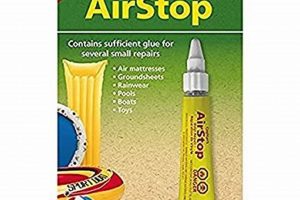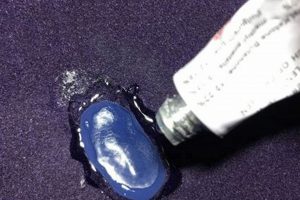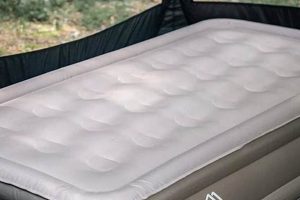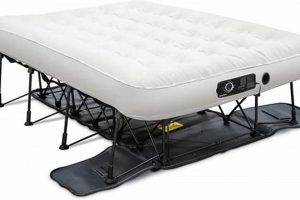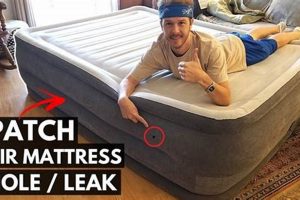Locating the source of escaping air from an inflatable sleeping surface is a necessary step to restore its functionality. Determining the precise location of such egress points is crucial for effective repair and the restoration of the mattress to its intended use. This process involves a systematic approach to identify where the compressed air is escaping from the mattress’s sealed structure.
Addressing air leakage promptly preserves the user’s comfort during sleep and extends the lifespan of the inflatable mattress. Moreover, pinpointing and patching the leak prevents further degradation of the material and reduces the likelihood of complete failure. Historically, various techniques have been employed, evolving from simple auditory detection to sophisticated submersion and soapy water methods.
The following outlines several established methods for identifying these problematic areas, ranging from visual inspections to more detailed, hands-on approaches. These techniques enable users to effectively search for the source of the leak and subsequently repair it.
Techniques for Leak Detection in Air Mattresses
The following techniques provide systematic guidance in locating the source of air leaks within an air mattress. Effective application of these strategies significantly increases the likelihood of successful leak identification and subsequent repair.
Tip 1: Visual Inspection: Begin by thoroughly examining the entire surface of the mattress. Look for any obvious punctures, tears, or areas of abrasion. Pay particular attention to seams and valve areas, as these are common points of failure.
Tip 2: Auditory Detection: In a quiet environment, inflate the mattress fully and listen closely for hissing sounds. Slowly move the ear along the surface of the mattress, concentrating on areas suspected to be leaking. Marking potential leak locations during this process is advisable.
Tip 3: Soapy Water Solution: Mix a mild liquid dish soap with water. Apply the solution to the mattress surface using a sponge or spray bottle. Observe closely for the formation of bubbles, which indicate escaping air. This method is particularly effective for locating small, difficult-to-find leaks.
Tip 4: Submersion Method: If the mattress is small enough, consider submerging it in a tub of water. The escaping air will manifest as bubbles rising to the surface, pinpointing the leak location. Ensure the valve is tightly sealed during this process to avoid misidentification.
Tip 5: The Pressurized Feel Method: After inflating the mattress fully, apply moderate pressure with a hand over suspected areas. A change in the feel, such as a slight give or a subtle air rush, can often help to narrow down the location of escaping air.
Tip 6: Valve Examination: Inspect the mattress valve for proper sealing. Ensure the valve is clean and free of debris that may prevent a tight seal. Applying a small amount of silicone grease can sometimes improve the valve’s sealing capability.
Tip 7: Segmented Approach: Divide the mattress surface into sections and systematically examine each segment using one or more of the methods described above. This approach helps to avoid overlooking potential leak locations.
Consistent and careful application of these techniques will greatly enhance the ability to locate and subsequently repair air leaks, extending the usable life of the air mattress.
With the location of the leak identified, appropriate repair strategies can be implemented to restore the air mattress to full functionality.
1. Visual Inspection
The initial stage in locating air leaks within an air mattress involves a thorough visual inspection. This process serves as a preliminary assessment, aiming to identify readily apparent punctures, tears, or material degradation that could be the source of air loss. The efficacy of subsequent leak detection methods often depends on the thoroughness of this initial visual scan. For example, a large tear along a seam might be immediately visible, negating the need for more complex techniques like soapy water application. Ignoring this step risks overlooking obvious problems, prolonging the overall troubleshooting process.
Specific areas warranting careful attention during visual inspection include seams, valve connections, and any areas exhibiting visible wear or abrasion. Seams are vulnerable due to the stress concentration at these points. Valve connections, being mechanical components, are susceptible to cracking or loosening. Abrasions, typically caused by friction against the floor or other surfaces, can weaken the mattress material and create pinhole leaks. For example, an air mattress used frequently on rough terrain might develop visible abrasions that are directly correlated with air leakage. The absence of visual cues, however, does not preclude the existence of a leak, necessitating the implementation of secondary detection methods.
In summary, visual inspection is a critical, albeit often underestimated, component of the leak detection process. Its effectiveness lies in its ability to identify obvious sources of air loss quickly and efficiently. While not a guaranteed solution for all leaks, its implementation as the first step streamlines the overall process and minimizes the time and resources required to locate and repair the damage. The failure to perform a comprehensive visual assessment can lead to overlooking simple solutions and prolonging the effort to restore the air mattress to its intended function.
2. Auditory Scanning
Auditory scanning, the act of listening for escaping air, represents a critical technique in the broader process of locating leaks within an air mattress. This method leverages the inherent acoustic properties of pressurized air escaping through a breach in a sealed environment, allowing the user to identify potential leak locations through careful listening.
- Ambient Noise Mitigation
The effectiveness of auditory scanning hinges significantly on minimizing ambient noise. A quiet environment allows subtle hissing sounds emanating from small leaks to become audible. External noises, such as traffic, electronic devices, or even human speech, can mask these sounds, rendering auditory detection ineffective. Conducting the scan in a secluded room or at a time when external disturbances are minimal is paramount. For instance, performing the scan in a busy household during the day would likely yield less accurate results than performing it late at night.
- Proximity and Position
The distance between the listener’s ear and the air mattress surface directly impacts the ability to detect leaks. Closer proximity increases the sound intensity, making faint hissing more perceptible. Systematic movement of the ear along the mattress surface, maintaining
a consistent distance, is essential. Additionally, varying the angle of approach can sometimes enhance the detection of leaks in recessed areas or along seams. Tilting the head and listening from different angles may reveal subtle air currents that are otherwise undetectable. - Frequency Range and Hearing Acuity
Air leaks often produce high-frequency sounds. The ability to perceive these frequencies varies among individuals based on age and potential hearing loss. Older individuals, or those with pre-existing hearing conditions, may find auditory scanning less reliable. Furthermore, certain environmental factors, such as the presence of high-frequency background noise, can interfere with the detection of leak-related sounds. Awareness of individual hearing limitations and the frequency characteristics of air leaks is crucial for accurate assessment. The use of hearing aids or amplification devices may be necessary in some cases.
- Leak Size and Pressure Relationship
The audibility of a leak is directly proportional to its size and the internal pressure of the air mattress. Larger leaks, or leaks occurring at higher internal pressures, produce louder, more easily detectable sounds. Conversely, small leaks, or leaks occurring in a partially deflated mattress, may be virtually silent. Ensuring the mattress is fully inflated prior to auditory scanning maximizes the internal pressure and increases the likelihood of detecting even minute leaks. The relationship between leak size, pressure, and audibility underscores the importance of proper inflation before commencing the scanning process.
These facets demonstrate the nuanced relationship between auditory scanning and the successful identification of air leaks. While seemingly straightforward, the technique relies on careful attention to environmental factors, individual capabilities, and the physical properties of air escaping under pressure. Mastering these aspects enhances the reliability of auditory scanning and contributes to a more effective leak detection strategy.
3. Soapy Water Test
The soapy water test is an established method for pinpointing air leaks in inflatable structures, including air mattresses. The procedure relies on the reduction of surface tension caused by soap, which allows for the formation of visible bubbles at the site of air egress. The escaping air, even in minuscule quantities, inflates these bubbles, thereby marking the location of the leak. The effectiveness of this technique is directly linked to the concentration of soap in the water, the pressure within the air mattress, and the ambient air currents. Too little soap may not produce discernible bubbles, while excessive soap can create a film that obscures smaller leaks. Low internal pressure will diminish the volume of escaping air, hindering bubble formation. Air currents can prematurely disperse bubbles, complicating the identification process. Understanding these variables is crucial for accurate application of the soapy water test.
The practical application of the soapy water test typically involves mixing a solution of mild liquid dish soap and water in a spray bottle or container. This solution is then liberally applied to the inflated air mattress surface, focusing on areas suspected of leaking. Close observation is necessary to detect the formation of bubbles, ranging from slow, expanding bubbles to rapidly forming ones. The size and rate of bubble formation correlate with the size of the leak. For instance, a slow, gradual bubble formation suggests a pinhole leak, whereas rapid bubble formation signifies a larger puncture or tear. The technique is particularly useful for locating leaks that are not readily apparent through visual inspection or auditory scanning. Examples include leaks along seams, around valve areas, and within the mattress material itself. This method excels at identifying these inconspicuous leaks.
In conclusion, the soapy water test is a valuable and accessible method for identifying air leaks in air mattresses. Its effectiveness hinges on understanding the interplay between solution concentration, internal pressure, and environmental factors. While not foolproof, its ability to reveal small leaks makes it an essential component of a comprehensive leak detection strategy. The practical significance of mastering this technique lies in its potential to extend the lifespan of air mattresses, prevent discomfort during use, and reduce the need for premature replacement.
4. Immersion Technique
The immersion technique, involving the submersion of an air mattress in water, is an effective method for identifying leak locations. Its efficacy stems from the principle that escaping air, when submerged, manifests as a stream of bubbles, directly indicating the point of egress. The technique is particularly valuable for locating small, difficult-to-detect leaks that may be missed by visual or auditory inspection. The size and frequency of the bubbles are proportional to the size of the leak, providing a visual indicator of its severity. The method depends on the maintenance of a pressure differential between the interior of the mattress and the surrounding water, ensuring air escapes at a detectable rate. For example, an air mattress with a pinhole leak, nearly imperceptible otherwise, will produce a continuous stream of small bubbles when submerged.
Practical application of the immersion technique requires a container large enough to fully submerge the air mattress, such as a bathtub or a large basin. The mattress is inflated, and care is taken to seal the inflation valve to prevent misleading bubble streams. The mattress is then gradually submerged, section by section, observing for the formation of bubbles. The process is repeated as necessary to thoroughly inspect the entire surface. The location of bubble streams is marked, typically with a marker or tape, for subsequent repair. Real-world applications demonstrate the technique’s utility in identifying leaks caused by small punctures from sharp objects, wear and tear along seams, or degradation of the mattress material. For instance, an air mattress used frequently outdoors may develop small leaks from contact with pebbles or thorns; these are readily identified through immersion.
In summary, the immersion technique is a valuable component of a comprehensive approach to detecting leaks in air mattresses. Its ability to visualize escaping air as bubble streams allows for precise leak localization, even in cases where other methods prove insufficient. While requiring a suitable container and careful execution, the benefits of accurate leak identification often outweigh the effort involved, ultimately extending the lifespan of the air mattress and ensuring continued usability. However, size constraints in submersion vessels and potential for water damage to internal components are valid practical considerations.
5. Pressure Sensitivity
Pressure sensitivity, defined as the tactile perception of subtle air movement or changes in surface resistance under applied force, serves as a valuable, albeit often overlooked, component in the process of identifying air leaks within an air mattress. The principle underpinning this technique lies in the
observation that escaping air creates a localized reduction in pressure, detectable as a slight give or softening of the mattress surface when pressure is applied directly over the leak. While not a definitive diagnostic tool on its own, pressure sensitivity can effectively narrow the search area, guiding the application of more precise leak detection methods such as the soapy water test or immersion.
The practical application of pressure sensitivity involves systematically applying moderate pressure with the hand or fingers to suspected leak locations. The user focuses on discerning subtle differences in the resistance offered by the mattress surface. A noticeable decrease in resistance, characterized by a sinking or yielding sensation, indicates a potential leak directly beneath the point of contact. For example, after visually identifying a small abrasion on the mattress surface, applying pressure to that area and noting a corresponding give would strongly suggest that the abrasion is indeed the source of an air leak. The efficacy of this technique is enhanced by a fully inflated mattress, as the greater internal pressure amplifies the pressure differential created by escaping air. This method can be especially useful along seams or around valve areas where visual identification may be obscured.
In summary, pressure sensitivity offers a supplementary, hands-on approach to locating air leaks in air mattresses. Its ability to identify localized pressure reductions can effectively guide the application of more definitive leak detection techniques, thereby accelerating the overall troubleshooting process. While requiring a degree of tactile sensitivity and a systematic approach, the integration of pressure sensitivity into the leak detection workflow can significantly improve the chances of accurately locating and repairing air leaks, ultimately extending the lifespan of the air mattress. However, the inherent subjectivity of tactile perception introduces a degree of variability, underscoring the need for corroboration with other methods.
6. Valve Examination
The examination of an air mattress valve constitutes a critical step in identifying the source of air leakage. A malfunctioning valve, whether due to physical damage, debris obstruction, or improper sealing, can lead to gradual or rapid deflation, mimicking the symptoms of a puncture within the mattress itself. This examination is often overlooked in initial troubleshooting, leading to potentially unnecessary and time-consuming searches for leaks elsewhere on the mattress. The valve’s role as the primary entry and exit point for air makes it a prime suspect when investigating air loss issues. For instance, a valve with a cracked housing will allow air to escape regardless of the mattress material’s integrity.
Valve examination involves several stages. First, a visual inspection is performed to identify any physical damage, such as cracks, breaks, or deformities in the valve body or cap. Next, the valve’s sealing mechanism is assessed. This may involve inflating the mattress and listening closely for escaping air around the valve area. Applying soapy water to the valve’s components can also reveal leaks through the formation of bubbles. Finally, the valve’s internal components are checked for obstructions, such as dust, dirt, or small particles that could prevent a proper seal. In cases where the valve core is removable, it should be inspected for damage or misalignment. A damaged or improperly seated valve core will permit uncontrolled air escape. Practical examples demonstrate the importance of this step; an air mattress stored in a dusty environment may experience valve obstruction leading to slow deflation, easily resolved through cleaning or core replacement.
In conclusion, valve examination is an indispensable procedure when seeking the source of air leakage in an air mattress. It addresses a common cause of deflation that, if left unchecked, can lead to misdiagnosis and ineffective repairs. The procedures relative simplicity and minimal resource requirements underscore its practical significance. Accurate valve assessment ensures resources are focused on legitimate mattress breaches, significantly improving the efficiency of the overall leak detection process. The oversight of this key inspection point frequently prolongs troubleshooting efforts unnecessarily.
7. Segmented Search
Segmented search, as applied to air mattress leak detection, is a systematic approach designed to enhance the efficiency and thoroughness of the inspection process. By dividing the mattress surface into manageable sections, it ensures that no area is overlooked and facilitates a more focused application of leak detection techniques. This strategy is particularly useful for large mattresses or in environments where ambient noise or visual distractions hinder the identification of subtle leaks.
- Defining Sections
The initial step in a segmented search involves partitioning the air mattress into distinct areas. These sections can be demarcated visually, using tape or markers, or mentally divided based on the mattress’s geometry or structural features (e.g., seams, baffles). Defining appropriately sized sections ensures that each area can be thoroughly inspected without overwhelming the searcher. For instance, a king-size air mattress might be divided into six to eight sections for optimal manageability, whereas a smaller twin mattress might only require four. The dimensions of these sections should be optimized to balance thoroughness and efficiency.
- Methodical Application
Once the mattress is segmented, each section is subjected to a specific leak detection method, or a combination of methods, in a sequential manner. For example, each section might first undergo visual inspection, followed by auditory scanning, and then a soapy water test. This systematic application prevents the searcher from haphazardly moving across the mattress and potentially missing subtle leaks. The methodical approach ensures a consistent level of scrutiny across the entire surface, reducing the likelihood of overlooking problematic areas. The use of a checklist or tracking system can further enhance the organization of this process.
- Adaptive Techniques
The segmented search approach allows for the adaptation of leak detection techniques based on the characteristics of each section. Areas with complex seams or valve attachments might require more meticulous soapy water testing, while larger, relatively flat surfaces might be more efficiently scanned visually or auditorily. This adaptive strategy optimizes the use of resources and maximizes the chances of identifying leaks in diverse areas of the mattress. For instance, if one section consistently exhibits a faint hissing sound during auditory scanning, the searcher can concentrate soapy water applications in that specific area.
- Documentation and Tracking
Effective implementation of a segmented search necessitates documentation and tracking of the inspection process. Marking inspected sections, noting potential leak locations, and recording the methods used in each area allows for a comprehensive overview of the search effort. This documentation is particularly useful when dealing with multiple individuals involved in the leak detection process or when revisiting the mattress for further inspection. Detailed records can prevent redundant efforts and facilitate the identificati
on of patterns or trends in leak locations. The use of photographs or sketches can further enhance the clarity of this documentation.
In summary, the segmented search strategy provides a structured and efficient framework for locating air leaks in air mattresses. By dividing the mattress into manageable sections, methodically applying leak detection techniques, adapting to the specific characteristics of each area, and documenting the inspection process, the segmented search significantly increases the likelihood of identifying and repairing leaks, ultimately prolonging the lifespan of the mattress.
Frequently Asked Questions
The following addresses common inquiries regarding the procedures for locating air leaks in air mattresses. It is intended to provide clarity and guidance on this essential maintenance task.
Question 1: Why is locating the source of air leakage critical for maintaining an air mattress?
Pinpointing the leak source enables effective repair, thereby extending the lifespan of the mattress. Untreated leaks worsen over time, leading to irreparable damage and premature disposal. Prompt detection allows for timely intervention, preserving the integrity and functionality of the mattress.
Question 2: What is the most effective method for finding a slow leak in an air mattress?
The soapy water test is generally considered the most effective. Small leaks, often undetectable by visual or auditory inspection, become visible through bubble formation when exposed to a soapy water solution. This method allows for precise localization of minute air egress points.
Question 3: Can the type of material affect the leak detection process?
Yes, the material composition can influence the ease of leak detection. Porous materials may diffuse air over a larger area, making leak localization more challenging. Conversely, non-porous materials concentrate the air egress, facilitating easier identification. The material’s color can also affect visual leak detection.
Question 4: How can the valve be assessed as a potential source of air leakage?
Valve assessment involves visual inspection for cracks or damage, auditory detection of escaping air around the valve area, and application of soapy water to reveal leaks. Ensuring the valve is properly sealed and free of debris is crucial. Replacement of the valve may be necessary in cases of irreversible damage.
Question 5: Is professional assistance recommended for air mattress leak detection and repair?
Professional assistance is generally not required for minor leaks that can be addressed with readily available repair kits. However, for extensive damage or uncertainty in leak location, professional assessment and repair may be advisable to ensure proper restoration of the mattress’s functionality.
Question 6: What preventative measures can be taken to minimize the risk of air mattress leaks?
Preventative measures include using a mattress protector, avoiding sharp objects or abrasive surfaces, properly storing the mattress when not in use, and maintaining appropriate inflation levels. These steps minimize stress on the mattress material and reduce the likelihood of puncture or wear.
Consistent and careful application of the techniques, including paying close attention to these preventative measures, should improve the effectiveness of leak detection in all but the most challenging circumstances.
With the above methods explored, one can confidently maintain and extend the utility of their air mattress.
Conclusion
This exploration of how to find a leak in an air mattress has outlined several systematic methods for identifying the source of air loss. Visual inspection, auditory scanning, soapy water application, immersion techniques, pressure sensitivity assessment, valve examination, and segmented search strategies each offer unique advantages in locating breaches within the mattress structure. The effective application of these techniques requires a methodical approach and attention to detail.
Mastery of these methods contributes to the extended lifespan and continued utility of air mattresses. Prioritizing accurate leak detection empowers users to address problems efficiently, preventing further degradation and ensuring comfortable and reliable use. Consistent attention to these diagnostic practices is a responsible approach to maintaining valuable equipment.


